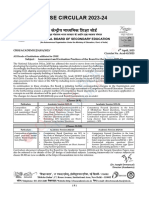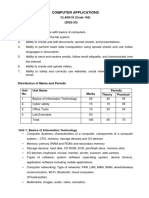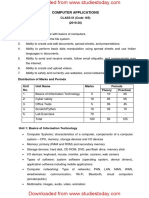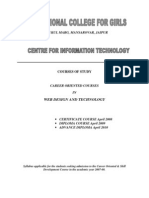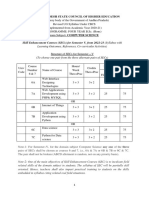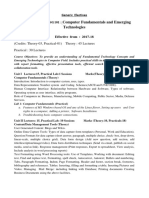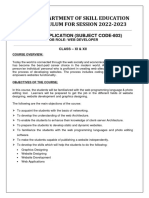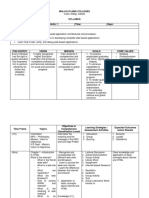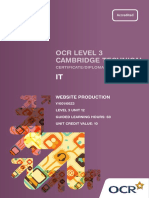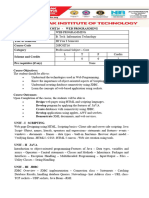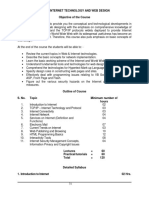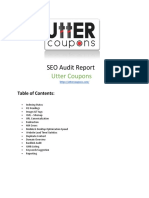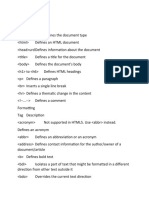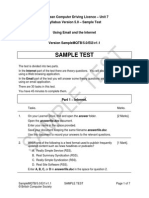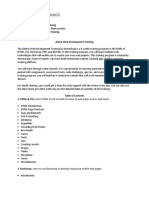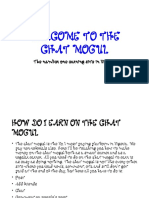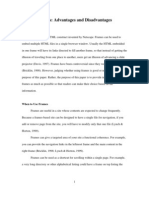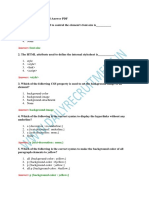Computer Applications
Subject Code - 165
CLASS X (2025-26)
Learning Outcomes
After the completion of the course, like student will be able to:
1. Understand the components of Computer Networking including web servers
and network protocols.
2. Explore the functionality and applications of the services available on the
Internet.
3. Create simple web pages using various HTML elements
4. Implement links and forms to create user-friendly web pages that facilitate
navigation and data collection.
5. Apply basic styling techniques using CSS to improve the visual appearance
and layout of web content.
6. Understand the importance of netiquettes, intellectual property rights, and
responsible online behaviour
Distribution of Marks and Periods
Periods
Unit
Unit Name Marks
No. Theory Practical
1. Networking 15 17 05
2. HTML 25 30 50
3. Cyber ethics 10 08 10
4. Practicals 50 - -
Total 100 55 65
Unit 1: Networking
• Internet: World Wide Web, web servers, web clients, web sites, web pages,
web browsers, blogs, news groups, HTML, web address, e-mail address,
downloading and uploading files from a remote site.
• Internet protocols: TCP/IP, SMTP, POP3, HTTP, HTTPS. Remote login and
file transfer protocols: SSH, SFTP, FTP, SCP, TELNET, SMTP, TCP/IP.
• Services available on the internet: information retrieval, locating sites using
search engines and finding people on the net;
• Web services: chat, email, video conferencing, e-Learning, e-Banking,
eShopping, e-Reservation, e-Governance, e-Groups, social networking.
• Mobile technologies: SMS, MMS, 3G, 4G, 5G
Unit 2: HTML
• Introduction to web page designing using HTML: create and save an HTML
document, access a web page using a web browser.
• HTML tags: html, head, title, body, (attributes: text, background, bgcolor,
link, vlink, alink), br (break), hr(horizontal rule), inserting comments, h1..h6
(heading),
p (paragraph), b (bold), i (italics), u (underline), ul (unordered list), ol
(ordered list), and li (list item). Description lists: dl, dt and dd. Attributes of
ol (start, type), ul (type).
• Font tags (attributes: face, size, color).
• Insert images: img (attributes: src, width, height, alt), sup (super script),
sub (subscript).
• HTML Forms: Textbox, radio buttons, checkbox, password, list, combobox.
• Embed audio and video in a HTML page.
• Create a table using the tags: table, tr, th, td, rowspan, colspan
• Links: significance of linking, anchor element (attributes: href, mailto),
targets.
• Cascading style sheets: colour, background-colour, border-style, margin,
height, width, outline, font (family, style, size), align, float.
Unit 3: Cyber ethics
• Netiquettes.
• Software licenses and the open source software movement.
• Intellectual property rights, plagiarism and digital property rights.
• Freedom of information and the digital divide.
• E-commerce: Privacy, fraud, secure data transmission.
4. Lab Exercises
• Create static web pages.
• Use style sheets to enforce a format in an HTML page (CSS).
• Embed pictures, audio and videos in an HTML page.
• Add tables and frames in an HTML page.
• Decorate web pages using graphical elements.
• Create a website using several web pages. Students may use any open
source or proprietary tool.
• Work with HTML forms: text box, radio buttons, checkbox, password, list,
combo box.
• Write a blog using HTML pages discussing viruses, malware, spam and
antiviruses
• Create a web page discussing plagiarism. List some reported cases of
plagiarism and the consequent punishment meted out. Explain the nature
of the punishment in different countries as per their IP laws.
Breakup of marks for the practicals:
S. No. Unit Name Marks
1. Lab Test
(20 marks)
HTML (design one web page based on a diagram) 20
2. Report File + viva
(20 marks)
Report file: At least 10 HTML pages 15
Viva voce (based on the report file) 5
3. Project (that uses most of the concepts that have been learnt)
(10 marks)
Total (50 marks)
*******************


